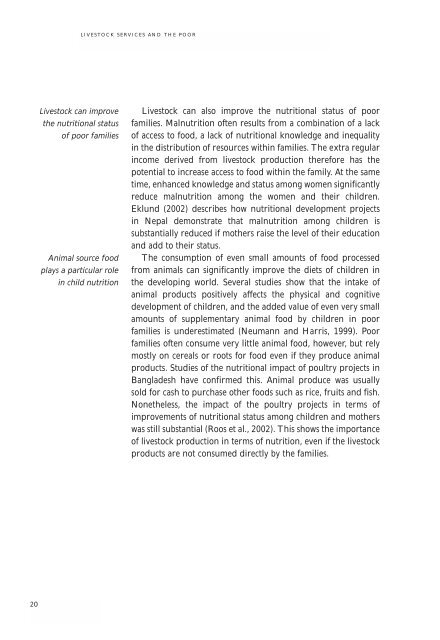Livestock Services and the Poor: A global initiative - IFAD
Livestock Services and the Poor: A global initiative - IFAD
Livestock Services and the Poor: A global initiative - IFAD
Create successful ePaper yourself
Turn your PDF publications into a flip-book with our unique Google optimized e-Paper software.
20<br />
LIVESTOCK SERVICES AND THE POOR<br />
<strong>Livestock</strong> can improve<br />
<strong>the</strong> nutritional status<br />
of poor families<br />
Animal source food<br />
plays a particular role<br />
in child nutrition<br />
<strong>Livestock</strong> can also improve <strong>the</strong> nutritional status of poor<br />
families. Malnutrition often results from a combination of a lack<br />
of access to food, a lack of nutritional knowledge <strong>and</strong> inequality<br />
in <strong>the</strong> distribution of resources within families. The extra regular<br />
income derived from livestock production <strong>the</strong>refore has <strong>the</strong><br />
potential to increase access to food within <strong>the</strong> family. At <strong>the</strong> same<br />
time, enhanced knowledge <strong>and</strong> status among women significantly<br />
reduce malnutrition among <strong>the</strong> women <strong>and</strong> <strong>the</strong>ir children.<br />
Eklund (2002) describes how nutritional development projects<br />
in Nepal demonstrate that malnutrition among children is<br />
substantially reduced if mo<strong>the</strong>rs raise <strong>the</strong> level of <strong>the</strong>ir education<br />
<strong>and</strong> add to <strong>the</strong>ir status.<br />
The consumption of even small amounts of food processed<br />
from animals can significantly improve <strong>the</strong> diets of children in<br />
<strong>the</strong> developing world. Several studies show that <strong>the</strong> intake of<br />
animal products positively affects <strong>the</strong> physical <strong>and</strong> cognitive<br />
development of children, <strong>and</strong> <strong>the</strong> added value of even very small<br />
amounts of supplementary animal food by children in poor<br />
families is underestimated (Neumann <strong>and</strong> Harris, 1999). <strong>Poor</strong><br />
families often consume very little animal food, however, but rely<br />
mostly on cereals or roots for food even if <strong>the</strong>y produce animal<br />
products. Studies of <strong>the</strong> nutritional impact of poultry projects in<br />
Bangladesh have confirmed this. Animal produce was usually<br />
sold for cash to purchase o<strong>the</strong>r foods such as rice, fruits <strong>and</strong> fish.<br />
None<strong>the</strong>less, <strong>the</strong> impact of <strong>the</strong> poultry projects in terms of<br />
improvements of nutritional status among children <strong>and</strong> mo<strong>the</strong>rs<br />
was still substantial (Roos et al., 2002). This shows <strong>the</strong> importance<br />
of livestock production in terms of nutrition, even if <strong>the</strong> livestock<br />
products are not consumed directly by <strong>the</strong> families.

















